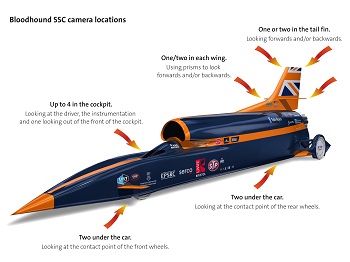The first phase of rocket plume imaging tests for the Bloodhound-SSC project has been conducted by Dr. Adam Baker at Kingston University in conjunction with STEMMER IMAGING in order to determine the optimum wavelength range for imaging.
Tests were carried out using cameras sensitive to the infrared, visible and UV regions of the spectrum, and the results can be seen on STEMMER IMAGING's video here.

Monitoring the output of the rocket plume is expected to play an important role in the optimisation of the rocket and jet engine-powered Bloodhound vehicle as it is developed for its world land speed record attempt. Initial expectations that UV imaging would prove more useful than IR imaging were confirmed during the tests.
The plume from a small hybrid rocket burning PMMA (acrylic) in a stream of oxygen was imaged using a Teledyne DALSA Genie M640 colour camera for the normal visible wavelength range; a JAI CM140GE UV camera for UV wavelengths and an AVT Goldeye P032 IR camera for infrared wavelengths.
The cameras were linked to an Adlink EOS embedded vision system equipped with an Intel Core i7 processor. Video was recorded using a custom version of the Vision Experts’ Gecko recording software, which also performs real-time video compression.
Further tests are likely to involve the construction of a small rocket set to allow the testing of multiple rocket nozzles from simulated angles. This will help to determine the best position for integrating the camera into the car.